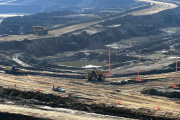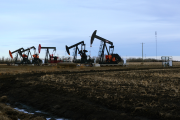It’s hard to believe five years have passed since 1600 ducks died after landing on a Syncrude tailings pond. The incident made headlines around the world, and kicked off an era of heightened international scrutiny and concerns related to the environmental impacts of oilsands development. And for good reason — the tailings waste produced from oilsands mining contains a host of toxins and seeps as much as 11 million litres per day of wastewater into the surrounding environment. Tailings reclamation is a financially risky and uncertain prospect.
Alberta’s premiers have responded to this scrutiny by trumpeting bold commitments to improve tailings management. In 2010, then-premier Ed Stelmach stated that companies would have to eliminate wet tailings ponds within "a few years" because they are a blight on Alberta's international image. More recently, current Premier Alison Redford said tailings would “disappear from Alberta’s landscape in the near future.”
Yet, despite a small number of technological advancements made by individual companies, the vast lakes of tailings waste from oilsands production continue to accumulate on the northeastern Alberta landscape.
Even more concerning is the fact that the companies responsible for producing this waste are consistently failing to meet provincial regulations governing the management of tailings — yet the province refuses to enforce its own rules or slow oilsands expansions until companies prove they can meet the province’s standards on existing projects.
The evolution of tailings management
Until three years ago, tailings management was largely voluntary, and companies were not even meeting the commitments they had made in their mining project applications. As a result, companies were facing unmanageable volumes of tailings waste requiring indefinite storage.
 In 2009, the Energy Resources Conservation Board (ERCB) finalized new tailings standards (called Directive 074) requiring oilsands companies to capture and dry a proportion of new tailings waste — as much as 50 per cent of new tailings by 2013.
In 2009, the Energy Resources Conservation Board (ERCB) finalized new tailings standards (called Directive 074) requiring oilsands companies to capture and dry a proportion of new tailings waste — as much as 50 per cent of new tailings by 2013.
It was a good first step that we hoped would set the foundation for more comprehensive regulations in the future. An ERCB spokesperson assured Albertans the government meant business when it came to enforcing these standards, and that oilsands producers would have to comply if they wanted their projects to continue operating.
Months later, however, the ERCB accepted the vast majority of operators’ tailings management plans — even though they did not comply with the new standards. The ERCB justified its flexible approach to enforcement by stating that the "imposition of the tailings management requirements may have significant impacts to existing and prospective oilsands mining operations."
We’d thought that was the point.
Alberta issues “get out of jail free” cards
Fast forward to June 2013: Late on a Friday afternoon the ERCB quietly posted a series of reports indicating that not a single company had met the tailings standards since the previous June.
In fact, companies weren’t even meeting the weaker targets they had negotiated with the regulator.
This time, the ERCB said it didn’t believe that enforcement would be appropriate because of the issues industry had encountered with implementing the standards. Zero compliance with already-weak tailings rules stands in stark contrast with Premier Redford’s promise that tailings lakes would “disappear from the landscape”.
At a time when Canada is so desperately trying to show it is managing the impacts of oilsands development in a responsible way, it’s not hard for Canadians — and our energy customers — to see through this hollow rhetoric.
And it’s not just Alberta’s tailings standards that are being badly enforced. A new report by independent scientists showed that Alberta enforces fewer than one per cent of potential environmental infractions by oilsands companies.
The next tailings management assessment report is scheduled for release in 2015. Only then will Alberta’s energy regulator assess whether enforcement actions are necessary for any companies that are failing to meet the government’s standards.
Meanwhile, Alberta continues to lose ground on tailings management — and on its public relations campaign to convince Canadians and the world that the oilsands are being responsibly developed. Having personally seen the area the oilsands tailings cover grow from the size of Sylvan Lake in 2006 to more than triple that today, it’s clear this trend will continue until the government takes its role as regulator seriously and begins holding industry to tailings management standards.
Alberta must enforce the existing standards and put in place a more comprehensive set of rules that deal with legacy tailings and the many reclamation challenges facing industry. Until the province takes leadership on this issue, tailings management will stand as a case study that directly contradicts the promises of “responsible” resource development, and a challenge that must be addressed as the oilsands industry attempts to gain the social licence to further expand production.
To learn more about tailings management, check out the fact sheet Losing Ground: why the problem of oilsands tailings waste keeps growing.




